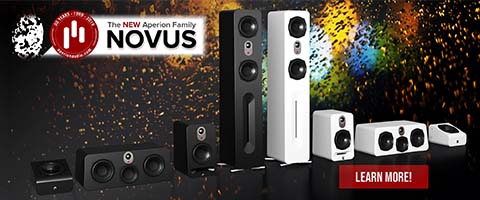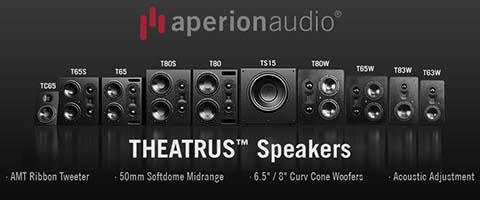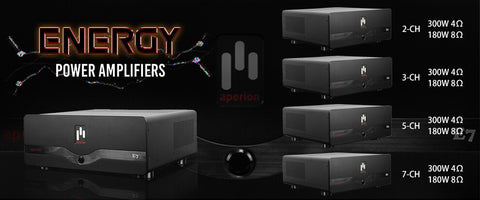Calibrating your home theater system is critical to an awesome home entertainment center, and only takes about 10 minutes to accomplish. The SPL meter measures the level of sound coming out of your speakers and it will help you fine-tune your system for the best possible sound.

To start, you’ll need to turn on your receiver and have the receiver’s remote handy. Now grab your Sound Pressure Level (SPL) meter and take a seat in your favorite chair. It’s time to calibrate!
- - - - - - - - - - - - - - - - - - - - - - - - - - - - - - - - - - - - - - - - - - - - - - - - - - - - - - - - - - - - - - - -
System Setup
- Are your speakers placed where they will live for years to come? If not, please check out our Aperion University course on Multi-channel Speaker Placement or make sure they’re in their final positions.
- Verify that the speaker wiring is correctly attached, that positive is connected to positive and that negative is connected to negative. If they’re wired incorrectly, the sound will be diffuse and hard to locate. So be sure everything is wired up properly before you start calibrating.
- Verify that your receiver has been configured properly.
- Speaker distance to the listening area is set to the correct distance.
- That the “Speaker Size” is correctly selected in the menu.
- If your receiver has a selectable crossover setting for your subwoofer, verify that is its set to manufacturer’s recommendation.
- - - - - - - - - - - - - - - - - - - - - - - - - - - - - - - - - - - - - - - - - - - - - - - - - - - - - - - - - - - - - - - -
Testing with the Aperion SPL Meter
- SPL Meter Setup: Remove the SPL meter from the box and pull the clear plastic battery protector from the slot on the right side. Turn the switch to the “BATT” position to ensure the meter is working properly. Next, switch the weighting to “C” and the response to “slow”. For most receivers, you will set the volume dial to 70 but if your receiver’s test tone is loud enough to “peg the meter,” set it to 80.
- SPL Meter Placement: Your SPL meter’s built-in microphone works best when it is pointed directly at the sound source and it should be placed as close as possible to where the primary listener’s ears will be. It’s best to use a tripod for placing the meter but if you don’t have a tripod, you can use other household items like a stepladder. Be sure the front of the meter extends a few inches beyond the support because you don’t want the microphone near anything that will reflect or absorb the sound.Stand off to the side of the SPL meter when making sound measurements. Because YOU absorb sound, standing behind the meter can produce an error of several decibels.
-
 Playing Test Tones: The test tone volume in your pre/pro or AV receiver will be set at a predetermined reference level. To play these test tones, enter the speaker setup menu and find the level calibration feature. Once you find that, enjoy the lush sound of test tone static. Try to disregard any unusual looks you get when someone catches you intently listening to static. They won’t understand.
Playing Test Tones: The test tone volume in your pre/pro or AV receiver will be set at a predetermined reference level. To play these test tones, enter the speaker setup menu and find the level calibration feature. Once you find that, enjoy the lush sound of test tone static. Try to disregard any unusual looks you get when someone catches you intently listening to static. They won’t understand. -
Speaker Level Calibration: Although many new receivers have an auto-calibration feature, using your SPL meter for calibration will result in much more accurate settings. To calibrate with your SPL meter, follow these steps:<
- Within your receiver’s setup menu, go to the level calibration function. This function is usually found under the speaker setup menu. If not, consult your receiver’s owner’s manual to find the level calibration feature.
- Using the SPL meter to measure each speaker’s volume level, adjust the volume of each speaker to get a uniform level. Depending on your circumstances there is a wide range of adjustments may be needed. Some will require very little adjustment and others may require significant volume changes.
- If your subwoofer is powered, it is recommended that you leave the subwoofer level set to the manufacturer’s recommended setting. Use the level control on the receiver to adjust your subwoofer volume to the uniform SPL of your system. Please note your SPL meter is accurate from 32Hz – 10 kHz using C weighting. If your receiver produces a 20 Hz test tone, you will need to add approximately 7 dB to the actual meter reading to correct for the SPL meter’s lower sensitivity at the lower frequencies.
- - - - - - - - - - - - - - - - - - - - - - - - - - - - - - - - - - - - - - - - - - - - - - - - - - - - - - - - - - - - - - - -
Advanced Calibration
If you would like to optimize your system more fully, you can use one of the popular calibration discs like AVIA or Digital Video Essentials. They offer advanced audio and video calibration and walk you through a step-by-step process of optimizing your entire system.
As always, if you have any questions call us at 1-888-880-8992, start a live chat, or email us at customerservices@aperionaudio.com.


 Playing Test Tones: The test tone volume in your pre/pro or AV receiver will be set at a predetermined reference level. To play these test tones, enter the speaker setup menu and find the level calibration feature. Once you find that, enjoy the lush sound of test tone static. Try to disregard any unusual looks you get when someone catches you intently listening to static. They won’t understand.
Playing Test Tones: The test tone volume in your pre/pro or AV receiver will be set at a predetermined reference level. To play these test tones, enter the speaker setup menu and find the level calibration feature. Once you find that, enjoy the lush sound of test tone static. Try to disregard any unusual looks you get when someone catches you intently listening to static. They won’t understand.









 https://www.aperionaudio.com
https://www.aperionaudio.com